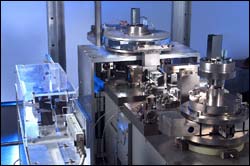E really does equal mc2 !

The GAMS4 instrument. Copyright ILL / Artechnique
One of the most striking predictions of Einstein’s theory of special relativity is probably the best known formula in all science: E = mc2. Today, exactly one hundred years after its first formulation, this equivalence has been verified to be correct at least to an accuracy of 4 parts in 10 000 000 ! These measurements, at the Institut Laue-Langevin, Grenoble, and the Massachussets Institute of Technology (MIT), represent the most precise verification of the relation between mass and energy ever achieved.
The direct test of Einstein’s equation is based on the prediction that when a nucleus captures a neutron, the resulting isotope (mass number A+1) is somewhat lighter than the sum of the masses of the original nucleus (mass number A) and the free neutron (mass number 1). The energy equivalent to this mass difference is emitted as a spectra of gamma-rays.
The mass difference in Einstein’s equation using two silicon isotopes 28-29Si and two sulphur isotopes 32-33S has been measured with very high accuracy on one side of the Atlantic at the MIT, using a novel experimental technique [2].
In parallel, on the other side of the Atlantic at the ILL, the energies of the gamma-rays emitted after neutron capture by both silicon and sulphur, have been measured by an international research team from the National Institute of Technologies and the Institut Laue-Langevin in Grenoble, using the world’s highest resolution gamma-ray interferometer GAMS4 [3]. Thanks to the combination of the very high neutron flux available at the ILL reactor and the exceptional energy resolution of the GAMS4 instrument, it was possible to determine the gamma-ray energies with a precision of better then 5 parts in 10 000 000.
From the comparison between the two values obtained on each side of the Atlantique – the mass difference measurements in America and the energy measurements in Europe -, it was possible to verify Einstein’s equation directly with a precision 55 times more accurate than existing measurements.
Even the most minute deviation from exact equality between energy and mass would have far reaching consequences for the whole of physics as it is today, from an understanding of the building blocks of matter to the evolution of the universe itself. The power of world-leading international collaborations of this kind, using the best facilities throughout the world, are needed to probe ever deeper into the mysteries of science.
Media Contact
All latest news from the category: Physics and Astronomy
This area deals with the fundamental laws and building blocks of nature and how they interact, the properties and the behavior of matter, and research into space and time and their structures.
innovations-report provides in-depth reports and articles on subjects such as astrophysics, laser technologies, nuclear, quantum, particle and solid-state physics, nanotechnologies, planetary research and findings (Mars, Venus) and developments related to the Hubble Telescope.
Newest articles
Humans vs Machines—Who’s Better at Recognizing Speech?
Are humans or machines better at recognizing speech? A new study shows that in noisy conditions, current automatic speech recognition (ASR) systems achieve remarkable accuracy and sometimes even surpass human…

Not Lost in Translation: AI Increases Sign Language Recognition Accuracy
Additional data can help differentiate subtle gestures, hand positions, facial expressions The Complexity of Sign Languages Sign languages have been developed by nations around the world to fit the local…

Breaking the Ice: Glacier Melting Alters Arctic Fjord Ecosystems
The regions of the Arctic are particularly vulnerable to climate change. However, there is a lack of comprehensive scientific information about the environmental changes there. Researchers from the Helmholtz Center…



